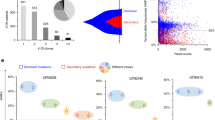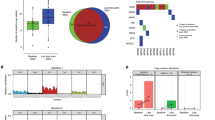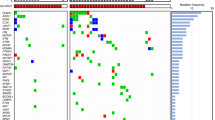Abstract
The genetics behind the progression of myelodysplasia to secondary acute myeloid leukemia (sAML) is poorly understood. In this study, we profiled somatic mutations and their dynamics using next generation sequencing on serial samples from a total of 124 patients, consisting of a 31 patient discovery cohort and 93 patients from two validation cohorts. Whole-exome analysis on the discovery cohort revealed that 29 of 31 patients carry mutations related to at least one of eight commonly mutated pathways in AML. Mutations in genes related to DNA methylation and splicing machinery were found in T-cell samples, which expand at the initial diagnosis of the myelodysplasia, suggesting their importance as early disease events. On the other hand, somatic variants associated with signaling pathways arise or their allelic burdens expand significantly during progression. Our results indicate a strong association between mutations in activated signaling pathways and sAML progression. Overall, we demonstrate that distinct categories of genetic lesions play roles at different stages of sAML in a generally fixed order.
This is a preview of subscription content, access via your institution
Access options
Subscribe to this journal
Receive 12 print issues and online access
$259.00 per year
only $21.58 per issue
Buy this article
- Purchase on Springer Link
- Instant access to full article PDF
Prices may be subject to local taxes which are calculated during checkout




Similar content being viewed by others
References
Greenberg P, Cox C, LeBeau MM, Fenaux P, Morel P, Sanz G et al. International scoring system for evaluating prognosis in myelodysplastic syndromes. Blood 1997; 89: 2079–2088.
Tefferi A, Vardiman JW . Classification and diagnosis of myeloproliferative neoplasms: The 2008 World Health Organization criteria and point-of-care diagnostic algorithms. Leukemia 2008; 22: 14–22.
Jaffe ES, Harris NL, Stein H, Vardiman JW . Tumours of haematopoietic and lymphoid tissues, WHO Classification of Tumours. WHO 2001.
Grimwade D, Ivey A, Huntly BJP . Molecular landscape of acute myeloid leukemia in younger adults and its clinical relevance. Blood 2016; 127: 29–41.
Papaemmanuil E, Gerstung M, Bullinger L, Gaidzik VI, Paschka P, Roberts ND et al. Genomic classification and prognosis in acute myeloid leukemia. N Engl J Med 2016; 374: 2209–2221.
Cancer Genome Atlas Research Network. Genomic and epigenomic landscapes of adult de novo acute myeloid leukemia. N Engl J Med 2013; 368: 2059–2074.
Vogelstein B, Papadopoulos N, Velculescu VE, Zhou S, Diaz LA, Kinzler KW . Cancer genome landscapes. Science 2013; 339: 1546–1558.
Greenberg PL, Stone RM, Bejar R, Bennett JM, Bloomfield CD, Borate U et al. Myelodysplastic syndromes, version 2.2015. J Natl Compr Canc Netw 2015; 13: 261–272.
Bejar R . Myelodysplastic syndromes diagnosis: what is the role of molecular testing? Curr Hematol Malig Rep 2015; 10: 282–291.
Yoshida K, Sanada M, Shiraishi Y, Nowak D, Nagata Y, Yamamoto R et al. Frequent pathway mutations of splicing machinery in myelodysplasia. Nature 2011; 478: 64–69.
Papaemmanuil E, Gerstung M, Malcovati L, Tauro S, Gundem G, Van Loo P et al. Clinical and biological implications of driver mutations in myelodysplastic syndromes. Blood 2013; 122: 3616–3627.
Haferlach T, Nagata Y, Grossmann V, Okuno Y, Bacher U, Nagae G et al. Landscape of genetic lesions in 944 patients with myelodysplastic syndromes. Leukemia 2014; 28: 241–247.
Delhommeau F, Dupont S, Valle Della V, James C, Trannoy S, Massé A et al. Mutation in TET2 in myeloid cancers. N Engl J Med 2009; 360: 2289–2301.
Bejar R, Stevenson K, Abdel-Wahab O, Galili N, Nilsson B, Garcia-Manero G et al. Clinical effect of point mutations in myelodysplastic syndromes. N Engl J Med 2011; 364: 2496–2506.
Walter MJ, Shen D, Shao J, Ding L, White BS, Kandoth C et al. Clonal diversity of recurrently mutated genes in myelodysplastic syndromes. Leukemia 2013; 27: 1275–1282.
Malcovati L, Papaemmanuil E, Bowen DT, Boultwood J, Porta Della MG, Pascutto C et al. Clinical significance of SF3B1 mutations in myelodysplastic syndromes and myelodysplastic/myeloproliferative neoplasms. Blood 2011; 118: 6239–6246.
Bejar R, Stevenson KE, Caughey B, Lindsley RC, Mar BG, Stojanov P et al. Somatic mutations predict poor outcome in patients with myelodysplastic syndrome after hematopoietic stem-cell transplantation. J Clin Oncol 2014; 32: 2691–2698.
Papaemmanuil E, Cazzola M, Boultwood J, Malcovati L, Vyas P, Bowen D et al. Somatic SF3B1 mutation in myelodysplasia with ring sideroblasts. N Engl J Med 2011; 365: 1384–1395.
Lindsley RC, Mar BG, Mazzola E, Grauman PV, Shareef S, Allen SL et al. Acute myeloid leukemia ontogeny is defined by distinct somatic mutations. Blood 2015; 125: 1367–1376.
Corces-Zimmerman MR, Hong W-J, Weissman IL, Medeiros BC, Majeti R . Preleukemic mutations in human acute myeloid leukemia affect epigenetic regulators and persist in remission. Proc Natl Acad Sci USA 2014; 111: 2548–2553.
Shlush LI, Zandi S, Mitchell A, Chen WC, Brandwein JM, Gupta V et al. Identification of pre-leukaemic haematopoietic stem cells in acute leukaemia. Nature 2014; 506: 328–333.
Bejar R . Clinical and genetic predictors of prognosis in myelodysplastic syndromes. Haematologica 2014; 99: 956–964.
Cazzola M, Porta Della MG, Malcovati L . The genetic basis of myelodysplasia and its clinical relevance. Blood 2013; 122: 4021–4034.
Cargo CA, Rowbotham N, Evans PA, Barrans SL, Bowen DT, Crouch S et al. Targeted sequencing identifies patients with preclinical MDS at high risk of disease progression. Blood 2015; 126: 2362–2365.
Meggendorfer M, De Albuquerque A, Nadarajah N, Alpermann T, Kern W, Steuer K et al. Karyotype evolution and acquisition of FLT3 or RAS pathway alterations drive progression of myelodysplastic syndrome to acute myeloid leukemia. Haematologica 2015; 100: e487–e490.
Shih L-Y, Huang C-F, Wang P-N, Wu J-H, Lin TL, Dunn P et al. Acquisition of FLT3 or N-ras mutations is frequently associated with progression of myelodysplastic syndrome to acute myeloid leukemia. Leukemia 2004; 18: 466–475.
van Kamp H, de Pijper C, Verlaan-de Vries M, Bos JL, Leeksma CH, Kerkhofs H et al. Longitudinal analysis of point mutations of the N-ras proto-oncogene in patients with myelodysplasia using archived blood smears. Blood 1992; 79: 1266–1270.
Horiike S, Misawa S, Nakai H, Kaneko H, Yokota S, Taniwaki M et al. N-ras mutation and karyotypic evolution are closely associated with leukemic transformation in myelodysplastic syndrome. Leukemia 1994; 8: 1331–1336.
Dicker F, Haferlach C, Sundermann J, Wendland N, Weiss T, Kern W et al. Mutation analysis for RUNX1, MLL-PTD, FLT3-ITD, NPM1 and NRAS in 269 patients with MDS or secondary AML. Leukemia 2010; 24: 1528–1532.
Makishima H, Yoshizato T, Yoshida K, Sekeres MA, Radivoyevitch T, Suzuki H et al. Dynamics of clonal evolution in myelodysplastic syndromes. Nat Genet 2016; e-pub ahead of print 19 December 2016 doi:10.1038/ng.3742.
Walter MJ, Shen D, Ding L, Shao J, Koboldt DC, Chen K et al. Clonal architecture of secondary acute myeloid leukemia. N Engl J Med 2012; 366: 1090–1098.
Kim TH, Yoshida K, Kim YK, Tyndel MS, Park HJ, Choi SH et al. Clonal dynamics in a single AML case tracked for 9 years reveals the complexity of leukemia progression. Leukemia 2015; 30: 295–302.
Chiba K, Shiraishi Y, Nagata Y, Yoshida K, Imoto S, Ogawa S et al. Genomon ITDetector: a tool for somatic internal tandem duplication detection from cancer genome sequencing data. Bioinformatics 2015; 31: 116–118.
Klco JM, Miller CA, Griffith M, Petti A, Spencer DH, Ketkar-Kulkarni S et al. Association between mutation clearance after induction therapy and outcomes in acute myeloid leukemia. JAMA 2015; 314: 811–822.
Steensma DP, Bejar R, Jaiswal S, Lindsley RC, Sekeres MA, Hasserjian RP et al. Clonal hematopoiesis of indeterminate potential and its distinction from myelodysplastic syndromes. Blood 2015; 126: 9–16.
Jaiswal S, Fontanillas P, Flannick J, Manning A, Grauman PV, Mar BG et al. Age-related clonal hematopoiesis associated with adverse outcomes. N Engl J Med 2014; 371: 2488–2498.
Acknowledgements
This study was supported by a grant from the Basic Science Research Program through the National Research Foundation of Korea (NRF), funded by the Ministry of Science, ICT and Future Planning (NRF-2015R1A2A1A10054579) and the Leading Foreign Research Institute Recruitment Program through the National Research Foundation of Korea (NRF), funded by the Ministry of Science, ICT and Future Planning (NRF-2011-0030034). The biospecimens and data used for this study were provided by the Biobank of Chonnam National University Hwasun Hospital, a member of the Korea Biobank Network. TK is supported by the Queen Elizabeth II Graduate Scholarship for Science and Technology (University of Toronto) and the scholarship from Natural Science and Engineering Research Council of Canada (NSERC-PGS D2). We thank Dr Aaron Schimmer and Dr Meong Hi Son for their insightful discussions and advice on the manuscript. In addition, they would like to thank the reviewers for their valuable comments and suggestions.
Author contributions
TK, HK, ZZ and DK designed the study and its concept. HP, SHC, JA, YK, DY, JL, SJ, SYK, YHM, JC, SKS and JHM collected the samples and performed experiments. YK, MST, MC, ML and ZZ analyzed the sequencing data. TK, MST, ZZ and DK performed all downstream and statistical analyses. TK, MST, HK, ZZ and DK wrote the manuscript.
Author information
Authors and Affiliations
Corresponding authors
Ethics declarations
Competing interests
The authors declare no conflict of interest.
Additional information
Supplementary Information accompanies this paper on the Leukemia website
Supplementary information
Rights and permissions
About this article
Cite this article
Kim, T., Tyndel, M., Kim, H. et al. The clonal origins of leukemic progression of myelodysplasia. Leukemia 31, 1928–1935 (2017). https://doi.org/10.1038/leu.2017.17
Received:
Revised:
Accepted:
Published:
Issue Date:
DOI: https://doi.org/10.1038/leu.2017.17
This article is cited by
-
Predictive values of mutational variant allele frequency in overall survival and leukemic progression of myelodysplastic syndromes
Journal of Cancer Research and Clinical Oncology (2022)
-
Aging and leukemic evolution of hematopoietic stem cells under various stress conditions
Inflammation and Regeneration (2020)
-
A genetic development route analysis on MDS subset carrying initial epigenetic gene mutations
Scientific Reports (2020)
-
NPM1 Biology in Myeloid Neoplasia
Current Hematologic Malignancy Reports (2020)
-
Myelodysplastic Syndromes: How to Recognize Risk and Avoid Acute Myeloid Leukemia Transformation
Current Oncology Reports (2020)



